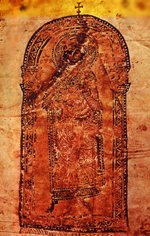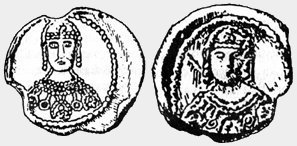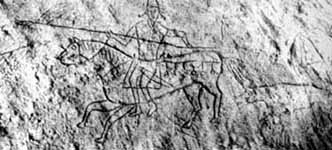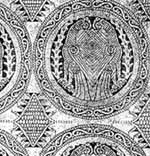Insignia and attire of the rulers of the First Bulgarian kingdom after the conversion to Christianity/864-1018/.
 |
Depiction of prince Boris I Michael from the Moscow copy of the Gospels by Constantine of Preslav (XII c.) |
With the conversion of the court and of the people Saint Boris-Mihail and his successors faced a new reality. As a result, of this the titles and the corresponding regalia were not only achievements, but also national symbols, identifying Bulgaria as an adequate participant in the political and clerical life of the civilized Christian world of that time.
Saint Boris I-Mihail /852-889/
Through clever, consistent yet realistic actions he managed to take a high enough place in the hierarchy of the Christian rulers, proof for which were the prestigious Caesar's regalia /the crown stephanos and the purple chlamys with fibula/, with which he is depicted on the miniature in the Moscow scripture of the Teacher's gospel of Constantin Preslavski. In contrast to Tervel, Boris Mihail was awarded with them by the Emperor not as a Byzantine dignitary, but as a ruler of an independent Christian state having an independent church. The time of Boris Mihail put the beginning of a steady tendency, according to which Byzantium began to send to its closest Christian rulers crowns and attire, used by the second most highly ranking dignitary in the empire - the Caesar until the end of the XI century, the sebastocrator until the second half of the XII century, and the despot in XIII-XV century
Tsar Simeon The Great /893-927/
After his ascending on the throne, tsar Simeon The Great began a real war for the most prestigious titles and insignia, which he brought to a victorious end and made an important break into the Byzantine oycumenistic doctrine /an idea of the worlds domination/. In this respect his achievements were without any analogy and even surpassed the achievements of Carl the Great from 25.12.800, when he was proclaimed and crowned for emperor by the Pope in the Saint Peter cathedral in Rome.
 |
"Anonimous" lead selas of Simeon the Great. |
In general there were three stages on the way of Simeon to the most prestigious ruler's insignia. It appears first of all, that in the year 893 he was crowned with the Caesar's regalia /the stephanos and the chlamys/, having been worn before by his father Boris-Mihail. After the important victories over the Byzantines and the Magyars in 895-904, he got a new self-confidence, inadequate with the archon title and the Caesar's regalia of his father. Then he made the first breakthrough in terms of the Byzantine ruler's insignia. We come to this conclusion judging by some portraits of him on the so called "anonymous" seals of Simeon and to a certain extent by a drawing in Preslav, where he is presented with an emperor's helmet, complemented by a crown-stemma and propendules and wearing a necklace-torque on his breast. These were regalia unused by the emperors at the end of the IX and X centuries, but were symbols of the soldier investiture of the first Christian emperors, preceding the civil and the clerical investiture in the Saint Sofia church. It seems that through them Simeon notified his opponents in Constantinople, that the procedure of taking up the emperor's throne is open /actually in IV-VI centuries the soldier's investiture with the torque and the helmet was carried out outside Constantinople/, and that it was only a question of time to conquer the capital and to perform the clerical investiture with the lorus and the stemma in the Saint Sofia church.
 |
Graffiti from preslav showin a ruler on horseback (Simeon the Great?) |
The second stage refers to the year 913, when after a series of victories won by Simeon was gorgeously received in Constantinople, but he was not hold in reverence as an emperor. At the same time in his view, and scrupulously seen examined in the view of the Byzantine doctrine, Byzantium did not have any legitimate emperor, as the infant Constantine VII was a child from the fourth marriage of Leo VI, whose legitimacy was contested by the patriarch. Then Simeon proclaimed himself as an emperor peacemaker and had himself depicted on the seals with a semispherical crown-kamelaukion, a sphere and a labarum. What dates back from that time is a gold seal-intalii and white-clay plate from the Oval church where the ruler is depicted with a low crown with trefoils, a sphere and a chlamys. This is not surprising, as his contemporary emperors usually used several sets of attire and crowns. It is impressive that Simeon manifestly encroached upon the ruler's insignia of the emperor's dignity. At last the kamelaukion and the crown with trefoils /hiperteron/ are associated with the legacy of Saint Constantine the Great and to the first Christian emperors. Even in the X century the kamelaukion was regarded as a sacred crown, sent by God to Saint Constantine the Great through an angel and put on the altar of Saint Sofia church. Viewed as such the crown should not be worn by the emperors until the end of XI century and it seems in this way that Simeon the Great was the first ruler in the Orthodox world crowned with it in order to present himself as chosen by God and as a direct continuator of the deed and legitimacy of Constantine the Great. Very impressive is also the text that accompanied the depiction: "Many happy returns of the day to the emperor peacemaker". The analogy with the entitling of Carl the Great and his acclaiming as an "emperor peacemaker" in the Saint Peter's church on 25.12.800 is almost absolute. Finally, according to some written and imitative sources, Carl the Great also presented his dignity of an emperor by a crown with trefoils, analogous to that of the plate from the Oval church and shown upon the seal-intalii of Simeon, as .well as by a chlamys and a sphere, whereas his successor Louse I was probably crowned with kamelaukion. So, it could definitely be asserted, that in terms of entitling and the insignia Simeon caught up in the year 913 with the German emperors and thus proclaimed the Third Christian empire. Nevertheless similar to Carl the Great, Simeon could not decide to proclaim himself as an emperor of Byzantium at this stage and to get the ruler's crown-stemma, because he hoped that through the planned marriage of his daughter to the infant Constantine VII he could become emperor's father in a lawful way and a Byzantine emperor afterwards. After Roman I Lapacin had ruined these hopes and after his unsuccessful attempt to seize Constantinople with Arab's help, Simeon had no other choice but make the last resolute step in the fight for the most prestigious title and regalia.
The third stage refers to the year 925, when the Bulgarian tsar proclaimed himself an emperor of the Byzantines. Of no effect were the suggestions of the patriarch Nikolay Misstic and the emperor Rouman I, that they were ready to acknowledge his title of emperor, provided that he renounce his title of emperor of the Byzantines /Carl the Great, himself, consented readily to such a compromise during the negotiations with Byzantium in the year 811 and at the signing of the peace treaty in the year 812!/. Proclaiming himself an emperor of the Byzantines in the year 925 and the taking away of the "constitutional" ruler's insignia/ the stemma with a cross, propendules, a cap, the lorus, the sphere and the cross of the ruler, with which he is depicted on the latest lead seal/, Simeon the Great surpassed the achievements of Carl the Great from the year of 800 and made the most important breakthrough in the Byzantine oycumenistic doctrine in the Middle Ages.
Tsar Peter I /927-970/
 |
lead seals of tsar Peter I and tsarina Maria, struck in the 940's, and a lead seal of tsar Peter, struck after 963 AD |
Simeon proclaimed himself an emperor of the Byzantines and crowned himself with the stemma, but neither Constantinople, nor Rome were inclined to sanction this action. Because of this, his successor Peter I made a number of retreats from the achievements of his father as regards to the entitling and the insignia. Byzantium, however, acknowledged the right of Bulgaria to have a patriarch; of Peter to take the emperor title /of course without the adjective "Byzantine"/ and to marry the Byzantine princess Maria-Irina, the granddaughter of Rouman I. As a result, the Bulgarian tsar juridically got the right to wear a stemma, a chlamys and a double ruler's cross. This was the case, obviously, only if Maria-Irina got the right, as on the first types of seals she is depicted together with Peter, and her hand, too, rests on the ruler's cross, by her husband's hand - a case without any precedent. Eloquent is also the invocational text: "Peter and Maria, rulers of the Bulgarians". Later /especially after the death of Maria and the dethroning of the sons of Rouman/ Peter worked his way to a more prestigious title /"autocrator", "despot", "pious emperor" and only "emperor" with the ambiguous omitting of "Bulgarian" but also without the adjective "Byzantine" /and especially to an insignia, reminding of his father's achievements. We judge of this by his depiction on the subsequent seals /perhaps after the year 963/ where he is shown with a semispherical kamelaukion, a lorus and a cross.
Tsar Boris II /970-971/ and Roman I /977-997/
 |
The dethroning of Boris II by John Tzimisces in Constantinople in 971 AD. Miniature in the Madrid copy of Skylitza |
We do not know exactly with which ornament was the successor of Saint Peter I, Boris II enthroned /970-971/, but Leo Dyakon and Scilitza describe in details the dethronement in the year 971 in Constantinople. They write not only of the stemma, the purple shoes and the royal mantle /the chlamys/, but also of a softcap-tiara and of some special crown /in the words of Leo Dyakon - a gorgeous crown/ , which he had given as a gift in Saint Sofia and which could be identified as a semispherical kamelaukion, known from the seals of Simeon the Great and of Peter I. Presumably the Bulgarian ruler Roman-Simeon /son of Peter I and brother of Boris II/ wore a stemma and attire made after a Praslav model, after his fleet from the Byzantine captivity and the ensuing enthroning as tsar on the idea of Samuil in the year 977 /perhaps in Ochrid/. After his second capture by the Byzantines in the year 991 and his death in the year 997, Samuil /997-1014/ was officially enthroned, who de facto ruled the state during Roman's reign /977-997/.
Tsar Samuil /997-1014/ and the last rulers of the First Bulgarian kingdom
 |
Gold-threaded cloth from the grave of Tsar Samuel in the "St. Achiles" basilica on the Prespa island |
For the time being we have no authentic depictions of Samuil /we could not entirely trust the miniature portrait on the manuscript of Scilitza in Madrid because it was made two centuries after his death/, but if seems, that he was also crowned with a stemma. In addition, his opened grave in the church Saint Ahil on the Prespa island also gave insufficient information about the insignia.
Indirect evidence show, that at the enthroning of Samuil a stemma was used again, as it was exactly stemma-crowns that were found in the treasure-house of the palace when Vassilii II seized Ochrid in the year 1018. Finally, a ruler is depicted with a stemma and a lorus in the rock niche near the village of Treklino, region of Kyustendil, who was identified after the monogram as the son of Samuil, Gavril-Radomir.
|

Representation of a ruler's crowning near the village of Treklino in the disctrict of Kjustendil, connected with tsar Gavril Radomir (1014-1015)
иии HOME иии
 Regalia, attire and religious beliefs of the first Bulgarian khans
Regalia, attire and religious beliefs of the first Bulgarian khans
 Insignia and attire of the Bulgarian rulers during the period of the Second kingdom (1185-1396)
Insignia and attire of the Bulgarian rulers during the period of the Second kingdom (1185-1396)
 Insignia and attire of the wives of the medieval Bulgarian rulers
Insignia and attire of the wives of the medieval Bulgarian rulers
 Insignia and attire of the Bulgarian high ranking dignitaries in the Middle Ages
Insignia and attire of the Bulgarian high ranking dignitaries in the Middle Ages
 About the treasure of Preslav and the insignia and the adornments of the noblest Bulgarian aristocrats during the Middle Ages
About the treasure of Preslav and the insignia and the adornments of the noblest Bulgarian aristocrats during the Middle Ages


Regalia, attire and religious beliefs of the first Bulgarian khans
Insignia and attire of the Bulgarian rulers during the period of the Second kingdom (1185-1396)
Insignia and attire of the wives of the medieval Bulgarian rulers
Insignia and attire of the Bulgarian high ranking dignitaries in the Middle Ages
About the treasure of Preslav and the insignia and the adornments of the noblest Bulgarian aristocrats during the Middle Ages